Investigation of Nonlinear Optical Processes in Mercury Sulfide Quantum Dots
Abstract
:1. Introduction
2. Methods and Materials
2.1. Experimental Arrangements
2.2. Preparation and Characterization of Samples
3. Measurements of the Nonlinear Optical Refraction and Nonlinear Absorption of HgS QD Samples
3.1. Application of Femtosecond Probe Pulses
3.2. Application of Nanosecond Probe Pulses
4. Third-Harmonic Generation in Thin Films
5. Discussion
6. Conclusions
Author Contributions
Funding
Data Availability Statement
Acknowledgments
Conflicts of Interest
References
- Higginson, K.A.; Kuno, M.; Bonevich, J.; Qadri, S.B.; Yousuf, A.M.; Mattoussi, H. Synthesis and Characterization of Colloidal β-HgS Quantum Dots. J. Phys. Chem. B 2002, 106, 9982–9985. [Google Scholar] [CrossRef]
- Shao, M.; Kong, L.; Li, Q.; Yu, W.; Qian, Y. Microwave-assisted synthesis of tube-like HgS nanoparticles in aqueous solution under ambient condition. Inorg. Chem. Commun. 2003, 6, 737–739. [Google Scholar] [CrossRef]
- Wang, H.; Zhu, J.-J. A sonochemical method for the selective synthesis of α-HgS and β-HgS nanoparticles. Ultrason. Sonochem. 2004, 11, 293–300. [Google Scholar] [CrossRef]
- Qin, D.Z.; Ma, X.M.; Yang, L.; Zhang, L.; Ma, Z.J.; Zhang, J. Biomimetic synthesis of HgS nanoparticles in the bovine serum albumin solution. J. Nanopart. Res. 2007, 10, 559–566. [Google Scholar] [CrossRef]
- Onwudiwe, D.C.; Ajibade, P.A. ZnS, CdS and HgS Nanoparticles via Alkyl-Phenyl Dithiocarbamate Complexes as Single Source Precursors. Int. J. Mol. Sci. 2011, 12, 5538–5551. [Google Scholar] [CrossRef] [Green Version]
- Marimuthu, G.; Ramalingam, K.; Rizzoli, C.; Arivanandhan, M. Solvothermal preparation of nano-β-HgS from a precursor, bis(dibenzyldithiocarbamato)mercury(II). J. Nanopart. Res. 2012, 14, 710. [Google Scholar] [CrossRef]
- Xu, X.; Carraway, E.R. Sonication-Assisted Synthesis of β-Mercuric Sulphide Nanoparticles. Nanomater. Nanotechnol. 2012, 2, 17. [Google Scholar] [CrossRef]
- Goswami, N.; Giri, A.; Kar, S.; Bootharaju, M.S.; John, R.; Xavier, P.L.; Pradeep, T.; Pal, S.K. Protein-Directed Synthesis of NIR-Emitting, Tunable HgS Quantum Dots and Their Applications in Metal-Ion Sensing. Small 2012, 8, 3175–3184. [Google Scholar] [CrossRef]
- Yang, J.; Zhang, W.-H.; Hu, Y.-P.; Yu, J.-S. Aqueous synthesis and characterization of glutathione-stabilized β-HgS nanocrystals with near-infrared photoluminescence. J. Colloid Interface Sci. 2012, 379, 8–13. [Google Scholar] [CrossRef]
- Han, L.; Hou, P.; Feng, Y.; Liu, H.; Li, J.; Peng, Z.; Yang, J. Phase transfer-based synthesis of HgS nanocrystals. Dalton Trans. 2014, 43, 11981–11987. [Google Scholar] [CrossRef]
- Selvaraj, R.; Qi, K.; Al-Kindy, S.M.Z.; Sillanpää, M.; Kim, Y.; Tai, C.-W. A simple hydrothermal route for the preparation of HgS nanoparticles and their photocatalytic activities. RSC Adv. 2014, 4, 15371–15376. [Google Scholar] [CrossRef]
- Zhang, L.; Du, X.; Yang, G.; Qin, D. Biomimetic synthesis and assembly of HgS nanocrystals via a protein inducing process. Res. Chem. Intermed. 2015, 41, 9067–9083. [Google Scholar] [CrossRef]
- Galain, I.; María, P.B.; Ivana, A.; Laura, F. Hydrothermal synthesis of alpha- and beta-HgS nanostructures. J. Cryst. Growth 2017, 457, 227–233. [Google Scholar] [CrossRef]
- Zhang, X.; Xiong, G.; Feng, X. Well width-dependent third-order optical nonlinearities of a ZnS/CdSe cylindrical quantum dot quantum well. J. Phys. E 2005, 33, 120–124. [Google Scholar] [CrossRef]
- Liu, X.N.; Yao, D.Z. Parameter-dependent third-order optical nonlinearity in a CdSe/ZnS quantum dot quantum well in the vicinity of a gold nanoparticle. Eur. Phys. J. B 2010, 78, 95–102. [Google Scholar] [CrossRef]
- Bahari, A.; Soltani, M.Z. Third-order harmonics generation in ZnS/CdSe/ZnS cylindrical nanoshells. Phys. Scr. 2013, 87, 025702. [Google Scholar] [CrossRef]
- Yan, M.; Yao, W.-D.; Liu, W.; Tang, R.-L.; Guo, S.-P. Helical {[HgS]}n chain-induced balanced nonlinear-optical performance for trigonal mercury sulfide. Inorg. Chem. 2021, 60, 16917–16921. [Google Scholar] [CrossRef]
- Sheik-Bahae, M.; Said, A.A.; Wei, T.-H.; Hagan, D.; Van Stryland, E.W. Sensitive measurement of optical nonlinearities using a single beam. IEEE J. Quantum Electron. 1990, 26, 760–769. [Google Scholar] [CrossRef] [Green Version]
- Goubet, N.; Jagtap, A.; Livache, C.; Martinez, B.; Portales, H.; Xu, X.Z.; Lobo, R.P.S.M.; Dubertret, B.; Lhuillier, E. Terahertz HgTe nanocrystals: Beyond confinement. J. Am. Chem. Soc. 2018, 140, 5033–5036. [Google Scholar] [CrossRef] [Green Version]
- Bundulis, A.; Shuklov, I.A.; Kim, V.V.; Mardini, A.A.; Grube, J.; Alnis, J.; Lizunova, A.A.; Razumov, V.F.; Ganeev, R.A. Nonlinear Absorption and Refraction of Picosecond and Femtosecond Pulses in HgTe Quantum Dot Films. Nanomaterials 2021, 11, 3351. [Google Scholar] [CrossRef]
- Wichiansee, W.; Nordin, M.N.; Green, M.; Curry, R.J. Synthesis and optical characterization of infra-red emitting mercury sulfide (HgS) quantum dots. J. Mater. Chem. 2011, 21, 7331–7336. [Google Scholar] [CrossRef]
- Yang, L.; Dorsinville, R.; Wang, Q.Z.; Ye, P.X.; Alfano, R.R.; Zamboni, R.; Taliani, C. Excited-state nonlinearity in polythiophene thin films investigated by the Z-scan technique. Opt. Lett. 1992, 17, 323–325. [Google Scholar] [CrossRef] [PubMed]
- Samoc, M.; Samoc, A.; Luther-Davies, B.; Reisch, H.; Scherf, U. Saturable absorption in poly(indenofluorene): A picket-fence polymer. Opt. Lett. 1998, 23, 1295–1297. [Google Scholar] [CrossRef]
- Ganeev, R.A.; Popov, V.S.; Zvyagin, A.I.; Lavrentyev, N.A.; Mirofyanchenko, A.E.; Mirofyanchenko, E.V.; Shuklov, I.A.; Ovchinnikov, O.V.; Ponomarenko, V.P.; Razumov, V.F. Exfoliated Bi2Te3 nanoparticle suspensions and films: Morphological and nonlinear optical characterization. Nanophotonics 2021, 10, 3857–3870. [Google Scholar] [CrossRef]
- Ganeev, R.A.; Boltaev, G.; Kim, V.; Zhang, K.; Zvyagin, A.; Smirnov, M.; Ovchinnikov, O.; Redkin, P.; Wöstmann, M.; Zacharias, H.; et al. Effective high-order harmonic generation from metal sulfide quantum dots. Opt. Express 2018, 26, 35013–35025. [Google Scholar] [CrossRef] [PubMed]
- Ganeev, R.A.; Boltaev, G.S.; Kim, V.V.; Venkatesh, M.; Zvyagin, A.I.; Smirnov, M.S.; Ovchinnikov, O.V.; Wöstmann, M.; Zacharias, H.; Guo, C. High-order harmonic generation using quasi-phase matching and two-color pump in the plasmas containing molecular and alloyed metal sulfide quantum dots. J. Appl. Phys. 2019, 126, 193103. [Google Scholar] [CrossRef]
- Ganeev, R.A.; Boltaev, G.S.; Kim, V.; Venkatesh, M.; Guo, C. Comparison studies of high-order harmonic generation in argon gas and different laser-produced plasmas. OSA Contin. 2019, 2, 2381–2390. [Google Scholar] [CrossRef]
- Ganeev, R.A.; Naik, P.A.; Singhal, H.; Chakera, J.A.; Gupta, P.D. Strong enhancement and extinction of single harmonic intensity in the mid- and end-plateau regions of the high harmonics generated in weakly excited laser plasmas. Opt. Lett. 2006, 32, 65–67. [Google Scholar] [CrossRef]
- Ganeev, R.A.; Shuklov, I.A.; Zvyagin, A.I.; Dyomkin, D.V.; Smirnov, M.S.; Ovchinnikov, O.V.; Lizunova, A.A.; Perepukhov, A.M.; Popov, V.S.; Razumov, V.F. Synthesis and low-order optical nonlinearities of colloidal HgSe quantum dots in the visible and near infrared ranges. Opt. Express 2021, 29, 16710–16726. [Google Scholar] [CrossRef]
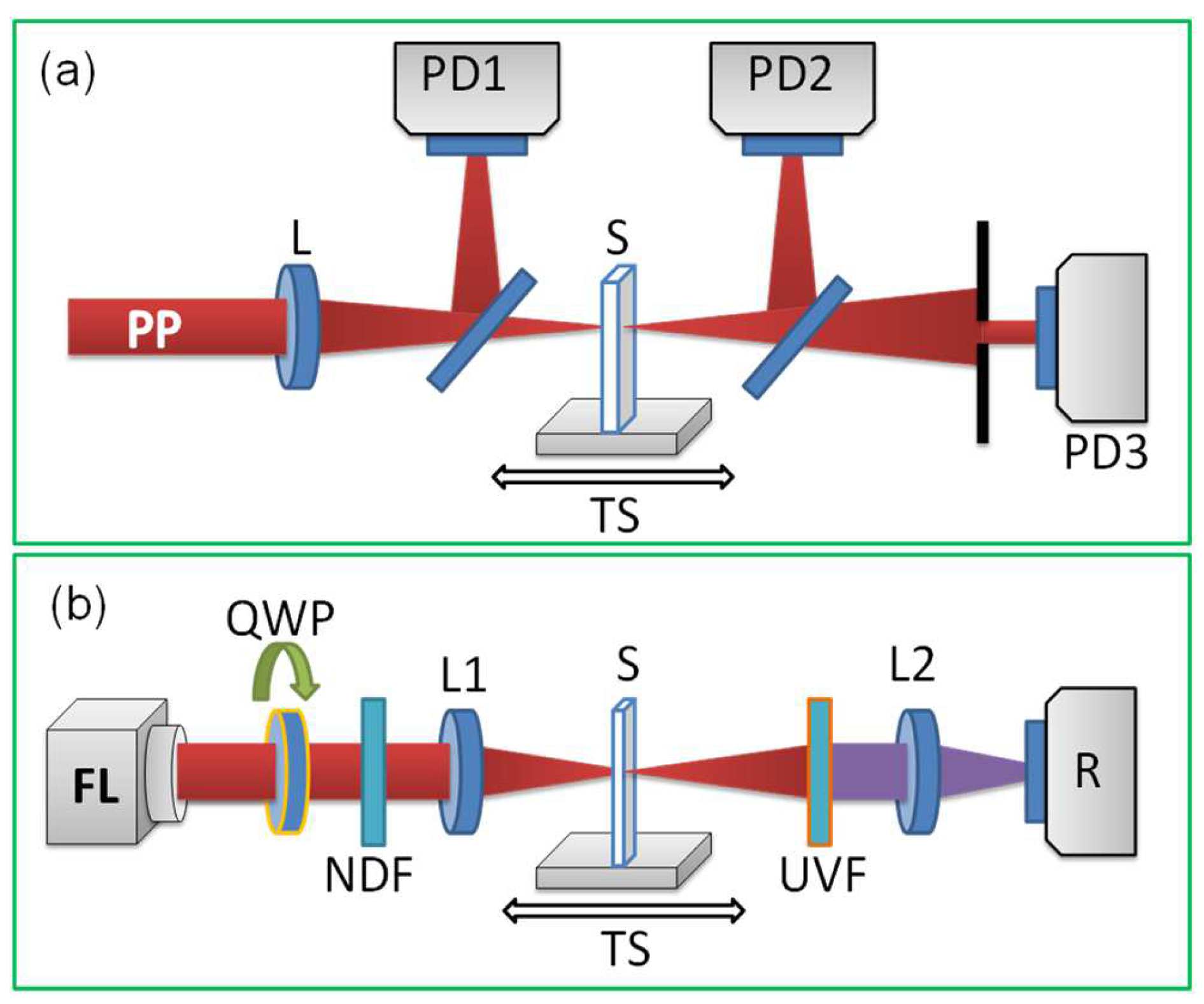

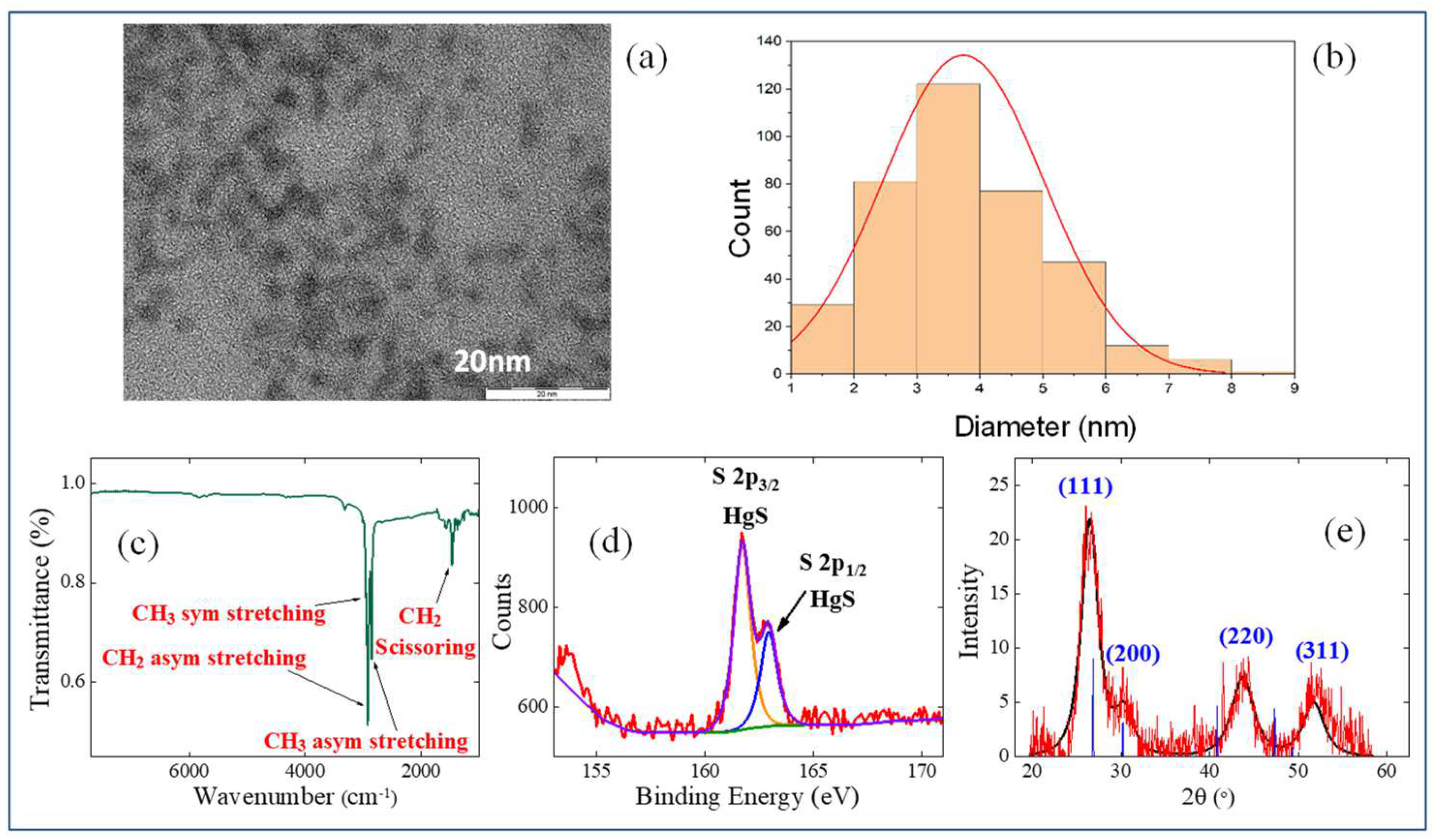

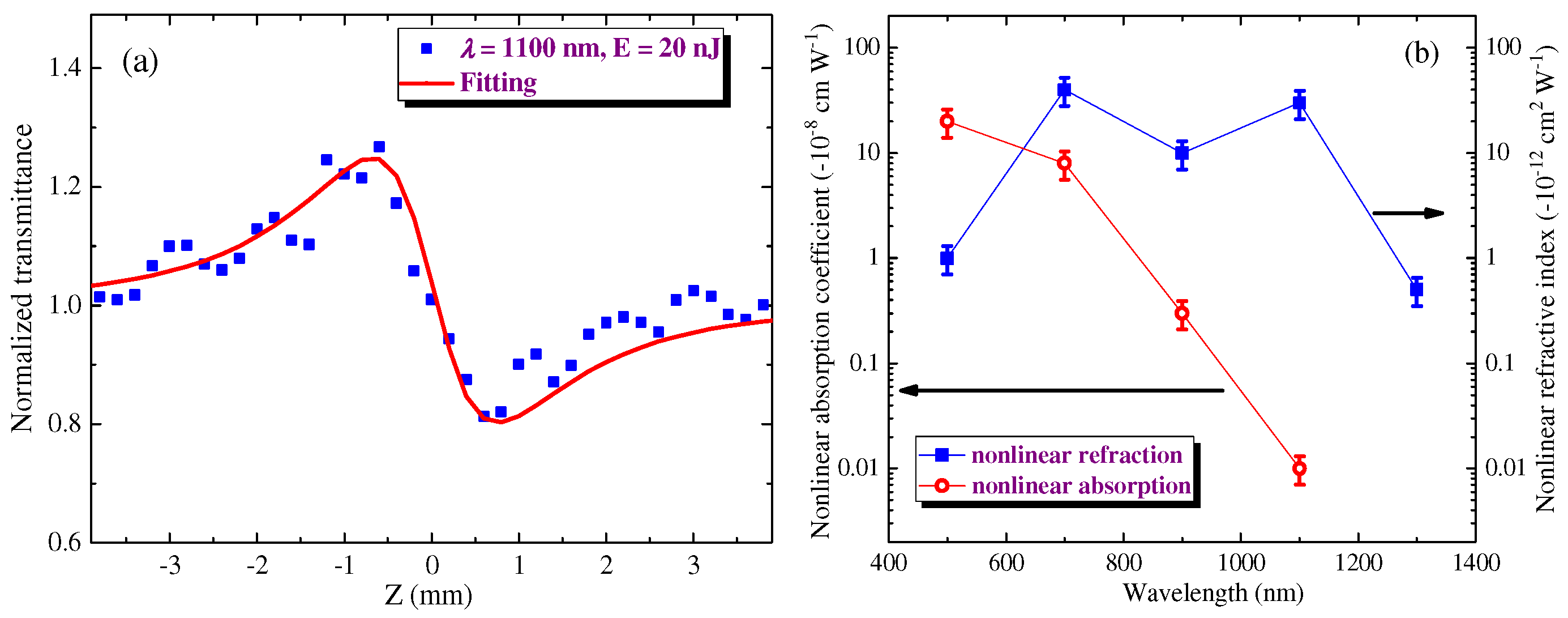
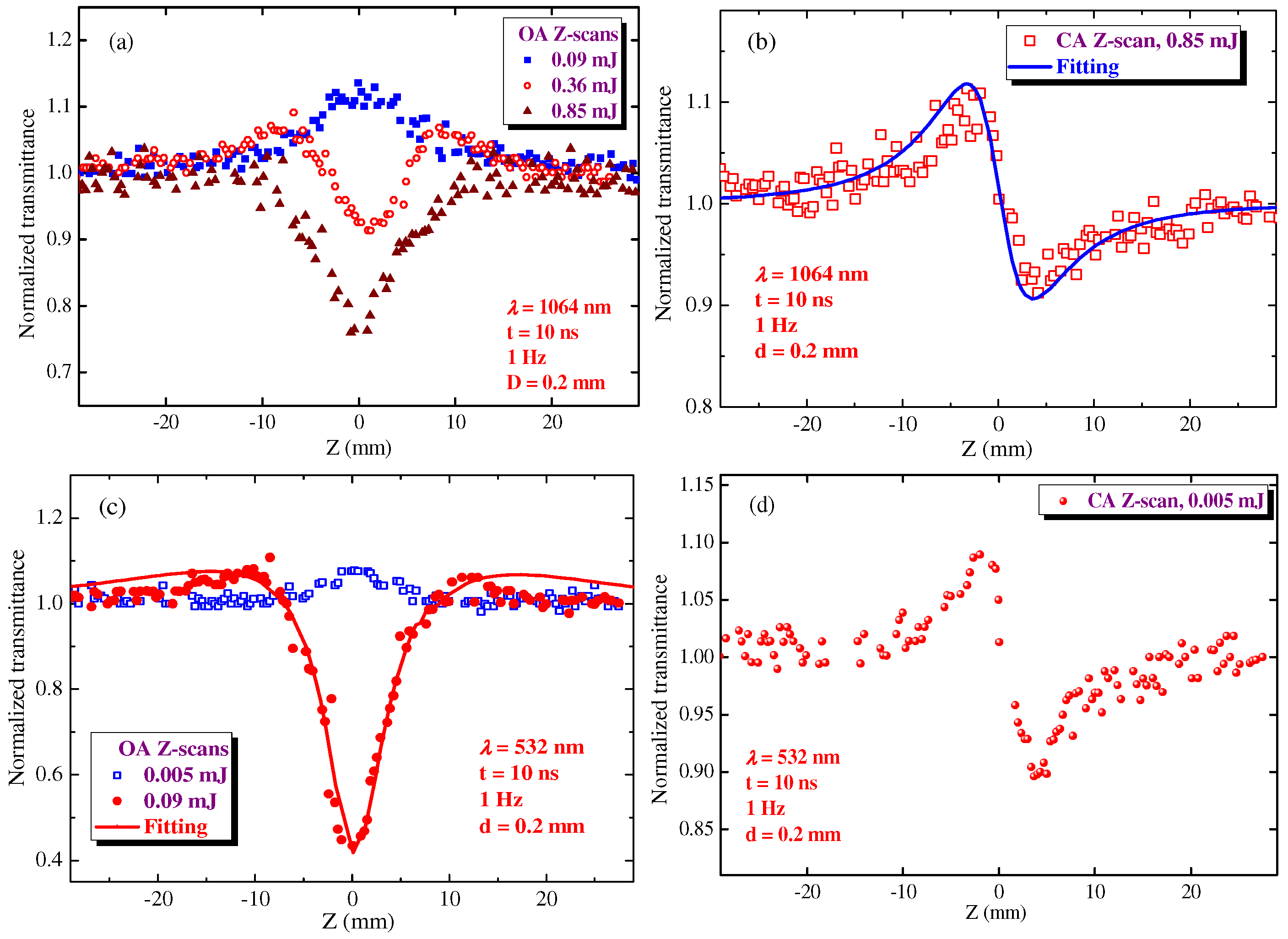

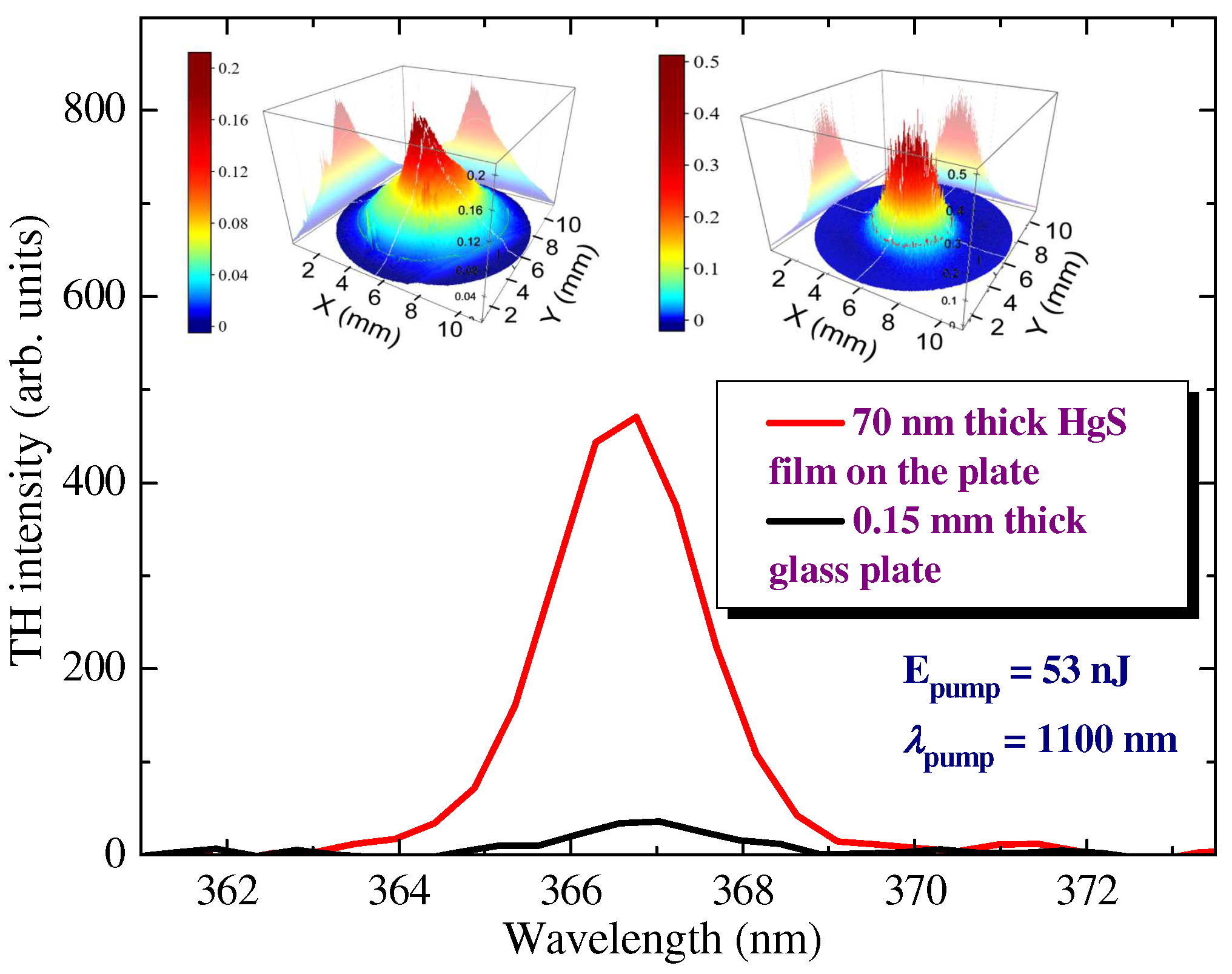
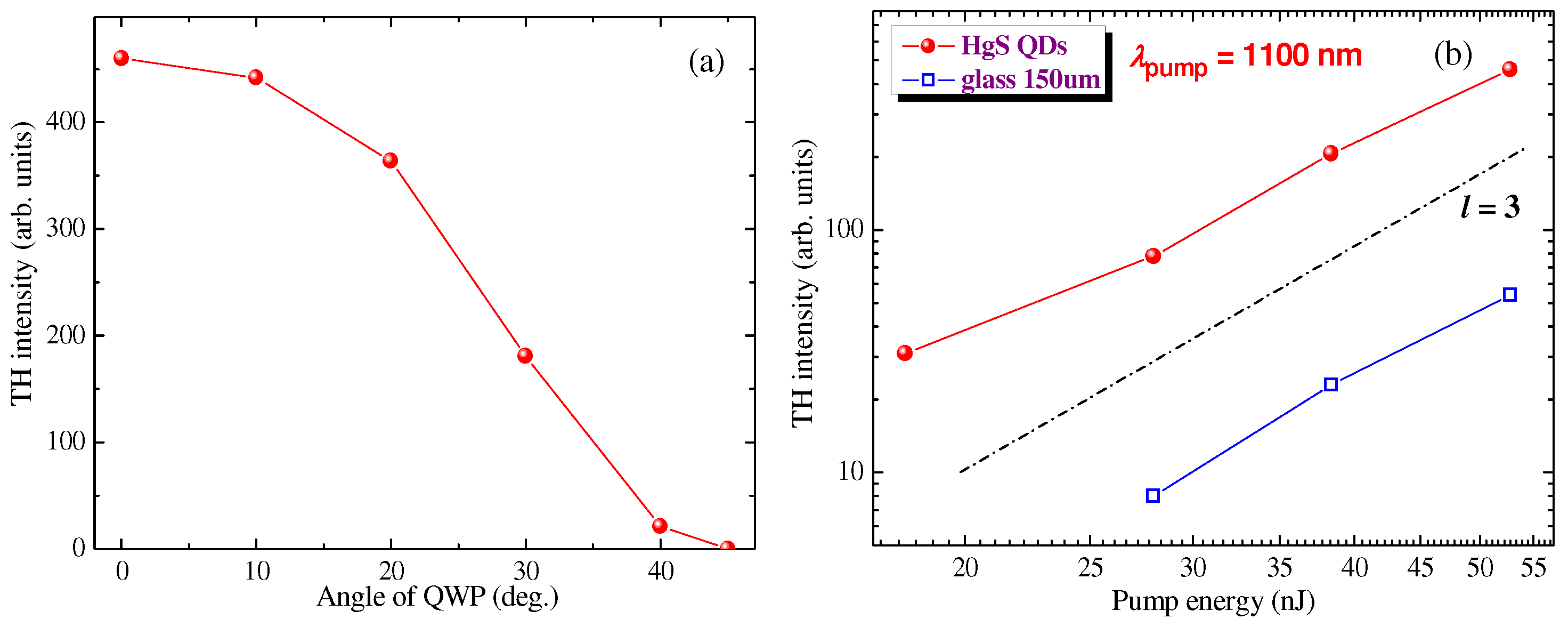
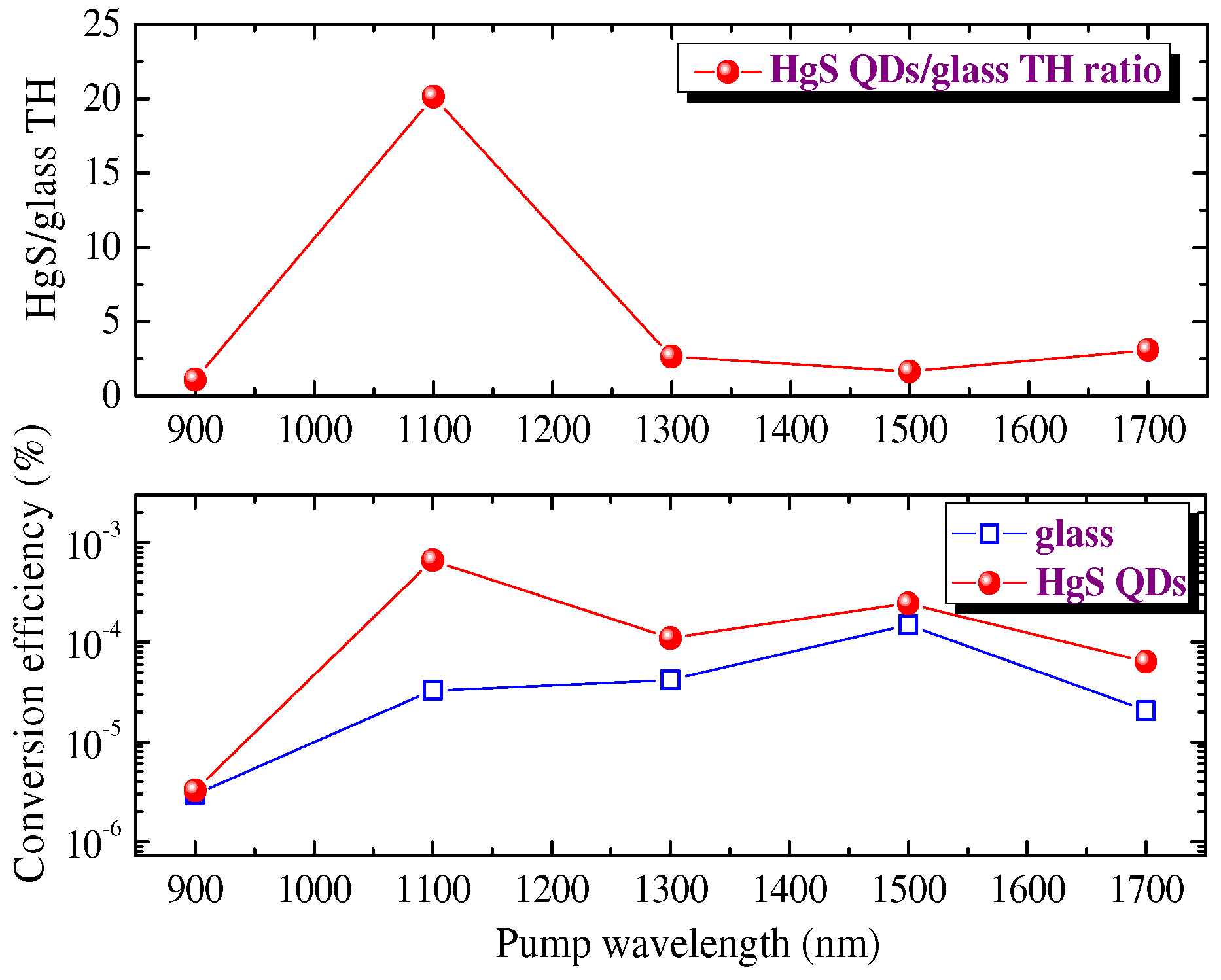
Publisher’s Note: MDPI stays neutral with regard to jurisdictional claims in published maps and institutional affiliations. |
© 2022 by the authors. Licensee MDPI, Basel, Switzerland. This article is an open access article distributed under the terms and conditions of the Creative Commons Attribution (CC BY) license (https://creativecommons.org/licenses/by/4.0/).
Share and Cite
Kim, V.V.; Shuklov, I.A.; Mardini, A.A.; Bundulis, A.; Zvyagin, A.I.; Kholany, R.; Lizunova, A.A.; Grube, J.; Sarakovskis, A.; Ovchinnikov, O.V.; et al. Investigation of Nonlinear Optical Processes in Mercury Sulfide Quantum Dots. Nanomaterials 2022, 12, 1264. https://doi.org/10.3390/nano12081264
Kim VV, Shuklov IA, Mardini AA, Bundulis A, Zvyagin AI, Kholany R, Lizunova AA, Grube J, Sarakovskis A, Ovchinnikov OV, et al. Investigation of Nonlinear Optical Processes in Mercury Sulfide Quantum Dots. Nanomaterials. 2022; 12(8):1264. https://doi.org/10.3390/nano12081264
Chicago/Turabian StyleKim, Vyacheslav V., Ivan A. Shuklov, Alaa A. Mardini, Arturs Bundulis, Andrey I. Zvyagin, Rawda Kholany, Anna A. Lizunova, Jurgis Grube, Anatolijs Sarakovskis, Oleg V. Ovchinnikov, and et al. 2022. "Investigation of Nonlinear Optical Processes in Mercury Sulfide Quantum Dots" Nanomaterials 12, no. 8: 1264. https://doi.org/10.3390/nano12081264





